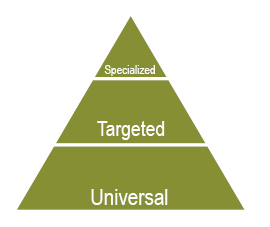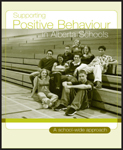
|
Universal Supports benefit all students
-
Work collaboratively with school staff to ensure that there are school-wide expectations for arriving to class on time and that this behaviour is supported and reinforced across the school day.
- Communicate clear expectations to students about the importance of arriving on time for class by:
- discussing the benefits of being on time
- reviewing schedules to ensure students understand exactly what constitutes being on time.
- Develop effective school-wide and classroom routines that support arriving to class on time, such as:
- coordinated bell schedules (with friendly warning bells that signal three minutes before final bell)
- assigned entrances and areas for removing and storing outdoor shoes.
- Provide motivating activities at the opening of the day or class, such as physical activity, brain teasers, joke of the day, or interesting historical or science facts.
- Post visual reminders of the daily schedule, including timelines. When appropriate, collaborate with students to develop these reminders.
- Use descriptive feedback to reinforce individuals, groups of students and/or the class as whole when they arrive to class on time.
|
|
 |
Targeted Supports benefit students with more specific needs
-
Pair individual students with positive peers who can serve as role models and provide support. Rotate these peers at regular intervals throughout the school year.
- As part of active supervision, provide individual students with increased proximity to ensure they proceed directly to the classroom at the bell.
- For students who require more structure and reassurance, develop and review social stories outlining routines that will support arriving to class on time.
- If there is a persistent pattern of arriving late to class:
- talk with the parents (and student if appropriate) to identify potential reasons for why their child is arriving late and to collaborate on identifying strategies to support their child in arriving on time
- talk with the student to identify if there are concerns at school, such as avoiding situations that may be stressful.
- Develop self-monitoring strategies students can use to keep track of their own progress in arriving to class on time. Some students may benefit from one-week or one-month goal setting for increasing the number of times they arrive to class on time.
- Develop a systematic approach to reinforcement, either at the class or individual level, to encourage students to arrive on time. Reinforcement should encourage moving toward intrinsic motivation (e.g., How does it feel when you …?).
|
Parents know their children well and can offer insights on how to support
their social and emotional well-being. There is strength in collaborating
on strategies that could be used at home, at school and in the community.
|
 |
Specialized Supports benefit the small number of students with sensory, physical, cognitive or behavioural needs that require intensive, individualized interventions
-
In exceptional situations, it may be necessary to provide 1:1 adult support to provide verbal guidance and physical prompting (or assistance, such as maneuvering a wheelchair) to ensure a student arrives safely and on time for class.
Parents know their children well and can offer insights on how to support their social and emotional well-being. There is strength in collaborating on strategies that could be used at home, at school and in the community.
|
|








